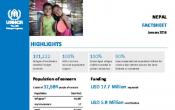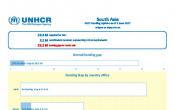Nepal
Operation: Nepal
Location
{"longitude":84,"latitude":28,"zoom_level":0}
Latest update of camps and office locations 21 Nov 2016. By clicking on the icons on the map, additional information is displayed.
Key Figures
| 2017 planning figures | |
| 70 | peaceful coexistence projects will be implemented (refugees from Bhutan) |
| 100% | of households will have access to sustainable energy (refugees from Bhutan) |
| 100% | of primary school-aged children will be enrolled in primary education (refugees from Bhutan) |
| 100% | of people of concern will have access to primary health care (urban refugees) |
| 100% | of primary school-aged children will be enrolled in primary education (urban refugees) |
| 2015 end-year results | |
| 6,560 | refugees departed for resettlement |
| 93% | of primary school-aged urban refugee children were enrolled in primary schools |
| 87% | of primary school-aged children in the camps were enrolled in primary education |
| 48% | female representation in camp committees |
| 41,575 | emergency shelters were provided |
Latest Updates
People of Concern
21%
Decrease in
2016
2016
| 2016 | 26,170 |
| 2015 | 33,068 |
| 2014 | 39,012 |

[["Refugees",25249],["Asylum-seekers",72],["Others of concern",849]]
Loading ...
Nepal
< Back
2016
{"categories":[2012,2013,2014,2015,2016,2017],"budget":[15.71760932,15.57919069,15.39627806,17.779095363,9.69132496,7.91013086],"expenditure":[10.68684716,8.69587504,7.64923815,10.25849726,6.59701288,null]}
{"categories":[2012,2013,2014,2015,2016,2017],"p1":[12.95508878,9.91735539,10.13508763,9.528128665,9.01183726,7.42166289],"p2":[1.35141954,1.40375575,2.23114183,1.794025568,0.6794877,0.48846797],"p3":[1.411101,4.25807955,3.0300486,2.52347713,null,null],"p4":[null,null,null,3.933464,null,null]}
{"categories":[2012,2013,2014,2015,2016,2017],"p1":[9.315841,6.85131978,6.78039167,5.72365518,6.19074725,null],"p2":[0.74722816,0.62798725,0.37696446,0.35181342,0.40626563,null],"p3":[0.623778,1.21656801,0.49188202,0.49332446,null,null],"p4":[null,null,null,3.6897042,null,null]}
Loading ...
CHOOSE A YEAR
- 2015
- 2016
- 2017
Working environment
In 2016, UNHCR reinforced efforts to find solutions for refugees, with an increasing focus on self-reliance, community-based approaches and strategic partnerships. Working closely with the national authorities, the Office supported projects which benefitted both refugees and host communities in the spheres of education, health, livelihoods, renewable energy and protection. UNHCR also engaged in various initiatives to ensure legal identity and promote the registration of persons of concern. Building upon positive legislative reforms in 2015, the Office and partners continued to provide legal advice to bring citizenship and civil registry provisions closer in line with international standards.Population trends
- With the conclusion of the large-scale resettlement programme, approximately 108,000 refugees from Bhutan were resettled by the end of 2016, with over 6,700 refugees departing in 2016 alone.
- The remaining camp population by the end of 2016 was just over 11,000, representing a substantial reduction in the overall refugee population in Nepal thanks to international burden-sharing and solidarity.
- UNHCR facilitated protection and catalysed increase self-reliance for approximately 600 urban refugees and asylum-seekers originating from over 12 different countries.
Achievements and impact
- With the conclusion of the large-scale resettlement programme for refugees from Bhutan in 2016, the Office launched a 3-year strategy to pursue alternative solutions, working in close collaboration with government, UN and NGO partners.
- Inter-agency task forces developed and implemented work plans in the spheres of education, health, livelihoods and protection, which benefited both refugees and host communities.
- The Office and partners reviewed vulnerability criteria and the needs of refugees, further targeting cash assistance, rationalising parallel services and, where feasible, mainstreaming refugees into local services and partner projects.
- Pregnant refugee women were given access to the national safe motherhood program, resulting in refugee women receiving prenatal care, intranatal and postnatal care services.
- An in-camp mass vaccination campaign for more than 1,800 children under 5 was conducted by the local health authorities, achieving 95.91 percent coverage.
Unmet needs
- By expanding its partnerships, including in the development context, UNHCR maximised its budget and largely addressed unmet needs. Certain gaps remained, however, in the context of shelter and site issues, particularly for the camp population of refugees from Bhutan.
- Restrictions on refugees working in the formal sector required UNHCR and partners to creatively develop options to address challenges in the sphere of livelihoods and self-reliance, whilst further targeting cash and material assistance to the most vulnerable.
Operational context and population trends
The overall security situation in Nepal remains stable. While political events since 2012 have not negatively impacted protection, assistance or resettlement activities, refugee issues have yet to gain prominence on the political agenda in Nepal.UNHCR supported the following four population groups in 2015:
Refugees from Bhutan: Submission for the group resettlement programme for refugees from Bhutan was completed in December 2015, with over 101,200 Bhutanese refugees having departed as of 31st December 2015. As a result of these resettlement departures, the camp population decreased to less than one sixth of its original population of approximately 108,000. Finding durable solutions for the remaining refugees continues to be a challenge. As of 31 December 2015, the two refugee camps in eastern Nepal hosted 17,134 refugees from Bhutan.
Urban asylum-seekers and refugees: UNHCR provided support to 702 urban refugees and asylum-seekers from 11 countries.
Tibetan refugees and new arrivals: UNHCR assisted 89 individuals in Kathmandu.
Individuals affected by the earthquake: In response to the devastating earthquakes that hit Nepal on 25 April and 12 May 2015, UNHCR worked closely with the Government and deployed 11,000 tarpaulins and 4,000 solar lamps from its regular stockpile to distribute across three earthquake-affected districts in central Nepal. Successful private sector fund raising in over 20 countries enabled UNHCR to assist over 200,000 individuals with 42,000 plastic sheets; over 8,000 families with solar lamps; 450 families with shelter roof kits; and over 10,000 children to resume education in the 170 temporary learning centres.
Key priorities in 2016
The objectives set by the Nepal operation are aligned with UNHCR’s global strategic priorities.Refugees from Bhutan:
- Continue to advocate for durable solutions for the remaining refugees in Nepal following the conclusion of the group resettlement programme;
- Maintain protection and assistance activities in the camps, in line with international standards;
- Support individual resettlement;
- Implement small-scale host community support projects;
- Enhance protection and community services, such as psycho-social support, child protection services, prevention of SGBV and suicide, women empowerment, support for youth and children with specific needs, and rehabilitation of substance abusers;
- These activities will be implemented for the benefit of both refugees and host communities with a view to strengthen joint support mechanisms with a linkage to district-level referral services.
- Provide assistance to cover basic needs, including a targeted subsistence allowance, primary health care services, and an education allowance for some 100 refugee children;
- Promote durable solutions, including self-reliance and resettlement to third countries for extremely vulnerable individuals or people facing high protection risks.
- Provide basic protection and assistance, including a subsistence allowance for onward movement, accommodation, food, and primary health care services for Tibetans transiting through Nepal;
- Continue to advocate with the Government at all levels for a comprehensive registration exercise for the long-staying Tibetan refugee population.
- Continue to advocate for citizenship documentation in line with international standards and provide relevant technical advice;
- Continue to engage in strategic partnerships with UN agencies, embassies, domestic legal experts and other civil society actors and pursue opportunities for collaboration on a larger scale with the Government in relation to citizenship.


